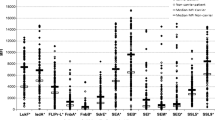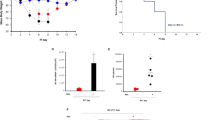Abstract
Staphylococcus aureus carriers have high-titer serum antibodies against non-enterotoxin gene cluster (egc) superantigens, whereas they lack anti-egc antibodies, suggesting different superantigen expression profiles in vivo. We measured the superantigen transcripts in S. aureus directly isolated from the nose of persistent carriers and correlated them with the superantigen-neutralizing antibody response. While neutralizing serum antibodies against the staphylococcal enterotoxins A and C (SEA and SEC) were found in carriers, antibodies against the egc-encoded staphylococcal enterotoxin-like toxin O (SElO) were rare. Surprisingly, the transcription of selo was comparable to sea and sec during nasal colonization. Thus, egc superantigens are transcribed during nasal colonization, but this is not sufficient to induce a serum antibody response.

Similar content being viewed by others
References
Wertheim HF, Melles DC, Vos MC, van Leeuwen W, van Belkum A, Verbrugh HA, Nouwen JL (2005) The role of nasal carriage in Staphylococcus aureus infections. Lancet Infect Dis 5(12):751–762
Kolata J, Bode LGM, Holtfreter S, Steil S, Kusch H, Holtfreter B, Hecker M, Engelmann S, van Belkum A, Völker U, Bröker BM (2011) Distinctive patterns in the human antibody response to Staphylococcus aureus bacteremia in carriers and non-carriers. Mol Cell Proteomics (in press)
Fraser JD, Proft T (2008) The bacterial superantigen and superantigen-like proteins. Immunol Rev 225:226–243
Becker K, Friedrich AW, Peters G, von Eiff C (2004) Systematic survey on the prevalence of genes coding for staphylococcal enterotoxins SElM, SElO, and SElN. Mol Nutr Food Res 48(7):488–495
Holtfreter S, Grumann D, Schmudde M, Nguyen HT, Eichler P, Strommenger B, Kopron K, Kolata J, Giedrys-Kalemba S, Steinmetz I, Witte W, Bröker BM (2007) Clonal distribution of superantigen genes in clinical Staphylococcus aureus isolates. J Clin Microbiol 45(8):2669–2680
Grumann D, Scharf SS, Holtfreter S, Kohler C, Steil L, Engelmann S, Hecker M, Völker U, Bröker BM (2008) Immune cell activation by enterotoxin gene cluster (egc)-encoded and non-egc superantigens from Staphylococcus aureus. J Immunol 181(7):5054–5061
Derzelle S, Dilasser F, Duquenne M, Deperrois V (2009) Differential temporal expression of the staphylococcal enterotoxins genes during cell growth. Food Microbiol 26(8):896–904
Kusch K, Hanke K, Holtfreter S, Schmudde M, Kohler C, Erck C, Wehland J, Hecker M, Ohlsen K, Bröker B, Engelmann S (2011) The influence of SaeRS and σ(B) on the expression of superantigens in different Staphylococcus aureus isolates. Int J Med Microbiol (in press)
Novick RP (2003) Autoinduction and signal transduction in the regulation of staphylococcal virulence. Mol Microbiol 48(6):1429–1449
Holtfreter S, Bauer K, Thomas D, Feig C, Lorenz V, Roschack K, Friebe E, Selleng K, Lövenich S, Greve T, Greinacher A, Panzig B, Engelmann S, Lina G, Bröker BM (2004) egc-Encoded superantigens from Staphylococcus aureus are neutralized by human sera much less efficiently than are classical staphylococcal enterotoxins or toxic shock syndrome toxin. Infect Immun 72(7):4061–4071
Takei S, Arora YK, Walker SM (1993) Intravenous immunoglobulin contains specific antibodies inhibitory to activation of T cells by staphylococcal toxin superantigens [see comment]. J Clin Invest 91(2):602–607
Holtfreter S, Roschack K, Eichler P, Eske K, Holtfreter B, Kohler C, Engelmann S, Hecker M, Greinacher A, Bröker BM (2006) Staphylococcus aureus carriers neutralize superantigens by antibodies specific for their colonizing strain: a potential explanation for their improved prognosis in severe sepsis. J Infect Dis 193(9):1275–1278
Grumann D, Ruotsalainen E, Kolata J, Kuusela P, Järvinen A, Kontinen VP, Bröker BM, Holtfreter S (2011) Characterization of infecting strains and superantigen-neutralizing antibodies in Staphylococcus aureus bacteremia. Clin Vaccine Immunol 18(3):487–493
Burian M, Wolz C, Goerke C (2010) Regulatory adaptation of Staphylococcus aureus during nasal colonization of humans. PLoS ONE 5(4):e10040
Burian M, Rautenberg M, Kohler T, Fritz M, Krismer B, Unger C, Hoffmann WH, Peschel A, Wolz C, Goerke C (2010) Temporal expression of adhesion factors and activity of global regulators during establishment of Staphylococcus aureus nasal colonization. J Infect Dis 201(9):1414–1421
Verkaik NJ, de Vogel CP, Boelens HA, Grumann D, Hoogenboezem T, Vink C, Hooijkaas H, Foster TJ, Verbrugh HA, van Belkum A, van Wamel WJ (2009) Anti-staphylococcal humoral immune response in persistent nasal carriers and noncarriers of Staphylococcus aureus. J Infect Dis 199(5):625–632
Verkaik NJ, Dauwalder O, Antri K, Boubekri I, de Vogel CP, Badiou C, Bes M, Vandenesch F, Tazir M, Hooijkaas H, Verbrugh HA, van Belkum A, Etienne J, Lina G, Ramdani-Bouguessa N, van Wamel WJ (2010) Immunogenicity of toxins during Staphylococcus aureus infection. Clin Infect Dis 50(1):61–68
Jarraud S, Peyrat MA, Lim A, Tristan A, Bes M, Mougel C, Etienne J, Vandenesch F, Bonneville M, Lina G (2001) egc, a highly prevalent operon of enterotoxin gene, forms a putative nursery of superantigens in Staphylococcus aureus. J Immunol 166(1):669–677
Monecke S, Luedicke C, Slickers P, Ehricht R (2009) Molecular epidemiology of Staphylococcus aureus in asymptomatic carriers. Eur J Clin Microbiol Infect Dis 28(9):1159–1165
Fueyo JM, Mendoza MC, Alvarez MA, Martín MC (2005) Relationships between toxin gene content and genetic background in nasal carried isolates of Staphylococcus aureus from Asturias, Spain. FEMS Microbiol Lett 243(2):447–454
Thomas D, Dauwalder O, Brun V, Badiou C, Ferry T, Etienne J, Vandenesch F, Lina G (2009) Staphylococcus aureus superantigens elicit redundant and extensive human Vbeta patterns. Infect Immun 77(5):2043–2050
Thomas D, Chou S, Dauwalder O, Lina G (2007) Diversity in Staphylococcus aureus enterotoxins. Chem Immunol Allergy 93:24–41
Holtfreter S, Nguyen TT, Wertheim H, Steil L, Kusch H, Truong QP, Engelmann S, Hecker M, Völker U, van Belkum A, Bröker BM (2009) Human immune proteome in experimental colonization with Staphylococcus aureus. Clin Vaccine Immunol 16(11):1607–1614
Burlak C, Hammer CH, Robinson MA, Whitney AR, McGavin MJ, Kreiswirth BN, Deleo FR (2007) Global analysis of community-associated methicillin-resistant Staphylococcus aureus exoproteins reveals molecules produced in vitro and during infection. Cell Microbiol 9(5):1172–1190
Colque-Navarro P, Söderquist B, Holmberg H, Blomqvist L, Olcén P, Möllby R (1998) Antibody response in Staphylococcus aureus septicaemia—a prospective study. J Med Microbiol 47(3):217–225
Kanclerski K, Söderquist B, Kjellgren M, Holmberg H, Möllby R (1996) Serum antibody response to Staphylococcus aureus enterotoxins and TSST-1 in patients with septicaemia. J Med Microbiol 44(3):171–177
Acknowledgments
This work was supported by grants from the Deutsche Forschungsgemeinschaft (DFG) (GRK840, SFB-TR34, SFB766), the Alfried Krupp Wissenschaftskolleg Greifswald, and the IZKF of Eberhard Karls University, Tübingen (1596-0-1). We thank Matthias Hauptmann (University Greifswald) and Gerard Lina (Centre National de référence des Staphylocoques) for kindly providing the SEC and SEA-MBP, respectively. We thank Vittoria Bisanzio for the expert technical assistance.
Conflict of interest
The authors do not have any commercial or other associations that might pose a conflict of interest.
Author information
Authors and Affiliations
Corresponding author
Additional information
Marc Burian and Dorothee Grumann contributed equally to this paper.
Rights and permissions
About this article
Cite this article
Burian, M., Grumann, D., Holtfreter, S. et al. Expression of staphylococcal superantigens during nasal colonization is not sufficient to induce a systemic neutralizing antibody response in humans. Eur J Clin Microbiol Infect Dis 31, 251–256 (2012). https://doi.org/10.1007/s10096-011-1302-2
Received:
Accepted:
Published:
Issue Date:
DOI: https://doi.org/10.1007/s10096-011-1302-2




